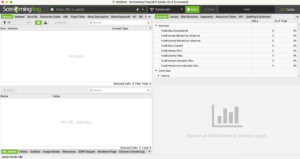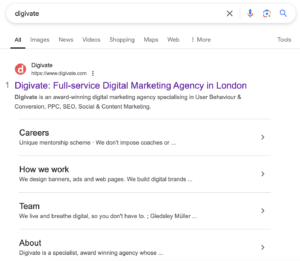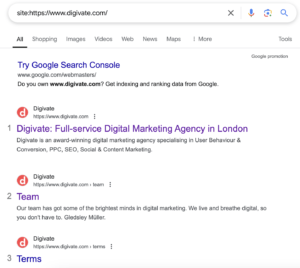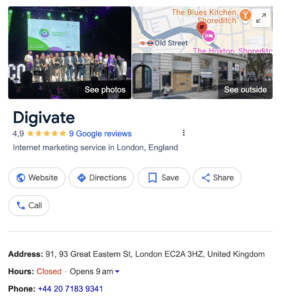
With all the competition out there, eCommerce businesses struggle to get their websites ranking well on search engines and in front of their target customers. So, how do you know if your SEO efforts are truly paying off?
Maybe you’re wondering if you could get similar results by following a random “SEO hacks” video or two. The truth is, effective SEO is more than just luck. It’s about understanding the core elements that drive rankings, and being ready to act on them.
Let’s Dig a Little Deeper: Why an Ecommerce SEO Audit Matters
SEO success isn’t just about having a great product or a visually appealing website design. Sure, those factors are important, but if search engines can’t find your site, understand its content, or recognise it as valuable, you’ll be left in the shadows of search results. That’s where an ecommerce SEO audit comes in.
A thorough technical SEO audit digs deep into various elements of your website to ensure that it’s optimised for search engines and designed to provide a seamless experience for your customers. Here’s why each of these elements matters:
- Crawlability: Google uses “crawlers” (bots) to explore the web and index pages. If these bots can’t access your website’s pages, they won’t show up in search results. This means you could be missing out on valuable traffic. Your audit should identify any obstacles to Google crawling your site, such as blocked resources, faulty robots.txt files, or issues with your XML sitemap. Fixing crawlability issues helps Google properly index your pages and makes sure they can be found by your audience.
- Content quality: Content is at the core of SEO. But it’s not just about having any content—your content needs to be relevant, valuable, and engaging. An audit evaluates whether your product descriptions, blog posts, category pages, and other key content pieces answer the questions your customers are asking and meet their needs. Is your content optimised with the right keywords? Does it provide clear, compelling reasons for visitors to engage and convert? Google’s algorithms reward high-quality content that serves user intent. If your content isn’t measuring up, it can be the difference between ranking on page one or fading into obscurity.
- Technical website audit: SEO isn’t just about great content—it’s also about a solid technical foundation. Your website needs to be structured in a way that makes sense to search engines and provides a smooth experience for visitors. A comprehensive SEO audit checks for issues like:
- Site speed: A slow-loading website can hurt both your rankings and user experience. Google prioritises fast, mobile-friendly websites.
- Mobile optimisation: With the majority of searches happening on mobile devices, Google uses mobile-first indexing. If your site isn’t mobile-friendly, it’s time to rethink your design.
- URL structure: Clean, descriptive URLs help search engines understand the content of a page and make it easier for users to navigate.
24 Key Elements of an Effective Ecommerce SEO Audit
1. Crawl the Website
Tools: Screaming Frog & Sitebulb (or Semrush)

A comprehensive crawl of your website helps identify crawl issues and assess how search engines interact with your pages. Screaming Frog allows you to filter pages by specific criteria like missing Google Analytics (GA) code, ensuring accurate tracking. Sitebulb offers valuable hints for optimising site structure and resolving issues related to crawlability.
2. Ranking for Own Brand Search
Tools: Search Engines

It’s essential that your website ranks first for your brand search. If your brand isn’t showing up in the top results, it could indicate issues with your SEO or brand visibility. Review your site’s content and SEO strategy to ensure that your branding is clear, optimised, and easy to find.
3. Crawl Budget
Tools: Google Search Console
Google allocates a specific crawl budget to your site, which determines how often it crawls and how many pages it indexes. You can optimise this by ensuring only high-priority pages are crawled and indexed. Review the “Crawl stats” in Google Search Console, and if you find a significant difference between the number of pages on your site and those crawled daily, you may need to optimise your crawl budget.
4. Paginated Content
Tools: Manual
For e-commerce websites with product categories or paginated content, ensuring proper pagination is crucial for crawl efficiency. Avoid using a “view all” page, implement self-referencing canonical tags, and optimise paginated pages to improve SEO. Don’t waste your crawl budget by including these pages in the XML sitemap unless necessary.
5. Current Indexation in Google
Tools: Search Engines

Perform a “site.com” search to determine which pages are indexed by Google. Look for any indexing issues, such as pages that shouldn’t be indexed, or vice versa. This helps ensure all important pages are visible in search results.
6. Anchor Text Link Distribution
Tools: Ahrefs or Semrush
Examine the distribution of anchor text within your site’s internal linking structure. Ensure that anchor texts are varied and relevant, as overuse of exact match anchors can lead to a penalty. Ahrefs can help identify opportunities to improve internal link distribution for better SEO performance.
7. Architecture Folder Structure
Tools: Screaming Frog
Review the hierarchy of your website’s structure. Pages should be logically organised in folders that make sense to both search engines and users. A confusing or disorganised structure can negatively affect crawl efficiency and user experience.
Hint: For a site audit you should first look at your navigation and main landing page categories.
8. Blog Content and Issues
Tools: Manual
Check the quality of your blog content i.e. do a content audit. Is it well-structured, relevant, and engaging? Also, ensure the blog is part of the site’s architecture and not buried or hidden. Great blog content can help attract organic traffic and build your authority in your niche.
9. Internal Broken Links
Tools: Screaming Frog & Sitebulb (or Semrush)
Regularly scan your website for internal broken links. Broken links make it harder for users to find the pages they are looking for and can negatively impact your SEO. Use tools like Screaming Frog and Sitebulb to identify and fix these issues quickly.
10. Canonicalisation
Tools: Screaming Frog
Proper canonicalisation helps prevent duplicate content issues by directing search engines to the primary version of a page. Use self-referencing canonical tags on key pages and ensure that pages with low value, such as duplicate or thin-content pages, are appropriately canonicalised or blocked from indexing.
11. GA Tracking on All Pages
Tools: Screaming Frog & Manual
Make sure that Google Analytics tracking is properly set up on every page of your website. This ensures accurate tracking and helps gather insights into user behaviour, which can guide your SEO strategy.
12. Duplicate Content
Tools: Screaming Frog
Check for duplicate content across your site. Duplicate content can confuse search engines and lead to ranking issues. If duplicate content is found, decide whether to consolidate pages or use canonical tags to indicate the preferred version.
13. External Links
Tools: Screaming Frog & Sitebulb (or Semrush)
Review your website for any broken or low-quality external links. Broken links can lead to poor user experience and impact SEO, while low-quality links can negatively affect your site’s authority. Ensure all external links are functioning and relevant.
14. Google Business Profile Issues and Improvements
Tools: Manual
 Review your Google Business Profile for completeness and accuracy. Ensure that key information such as your business description, contact details, images, and reviews are optimised. A well-maintained Google Business Profile can improve local SEO and credibility.
Review your Google Business Profile for completeness and accuracy. Ensure that key information such as your business description, contact details, images, and reviews are optimised. A well-maintained Google Business Profile can improve local SEO and credibility.
15. Mobile-Friendly Elements
Tools: Google Mobile-Friendly Test
With mobile-first indexing, ensuring that your site is mobile-friendly is essential. Use PageSpeed Insights tool to identify any issues with the mobile version of your site and optimise accordingly.
16. 301 Redirected Chains
Tools: Screaming Frog (or Semrush)
Check for any 301 redirect chains—where multiple redirects occur before reaching the final destination. These can slow down page load times and negatively impact SEO. Clean up any redirect chains to ensure faster page speed and improved user experience.
17. Page Speed & Core Web Vitals Issues
Tools: PageSpeed Insights
Google considers page speed and Core Web Vitals as ranking factors. Use tools like PageSpeed Insights to identify issues that may be slowing down your website. Optimise image sizes, reduce JavaScript execution time, and implement other improvements to enhance site performance.
18. Broken Backlinks
Tools: Ahrefs or Semrush
Examine your backlink profile for any broken backlinks. Backlinks are essential for SEO, and broken links can harm your site’s authority. Backlinks are a vote of confidence in your website – after all, it isn’t just on-page SEO that matters, it’s off-page SEO too.
19. H1 and H2 Tag Usage
Tools: Screaming Frog & Sitebulb
Ensure that H1 and H2 tags are used properly on your pages. H1 tags should be unique for each page, and H2 tags should structure content logically. Proper use of header tags improves the readability of your pages and signals to search engines what your content is about.
20. Thin Content
Tools: Sitebulb & Screaming Frog
Identify pages with little to no content. These pages are typically seen as low-value by search engines and may not rank well. Consider adding more comprehensive content or removing these pages if they don’t serve any purpose.
21. Trust and Credibility Signals
Tools: Manual

Check how your website displays trust and credibility signals, such as reviews, testimonials, or industry certifications. Clear trust signals can improve user confidence and help increase conversions.
22. Metadata
Tools: ScreamingFrog, Manual or Semrush
Ensure each page has a unique, keyword-optimised meta title that accurately describes the product or category. Titles should be within 50-60 characters to avoid truncation in search results.
Review meta descriptions for relevance, uniqueness, and use of target keywords. Descriptions should be around 150-160 characters and written to appeal to the user, as they directly impact click-through rates.
23. Image Alt Text
Tools: ScreamingFrog
Check that images, especially product photos, have descriptive alt text with relevant keywords. This improves accessibility and helps images appear in image search results.
24. Heavy Images
Tools: ScreamingFrog
Check that all images on your online store are compressed without losing quality. Large images can drastically increase load times, so using formats like WebP, which provide high quality at smaller file sizes, can help optimise speed.
How to Measure SEO Performance
While ranking positions are essential, they don’t tell the whole story. Successful SEO is about driving meaningful, sustained results, and this goes beyond just securing the top spot on search engine results pages (SERPs). Here are other key metrics to track:
- Conversion rate optimisation (CRO): One of the most crucial indicators of SEO success is whether your traffic translates into conversions, whether that’s sales, form submissions, or other key actions. High-quality traffic that doesn’t convert indicates that there’s more to optimise, whether it’s the landing page design, content, or user experience. By measuring your conversion rate, you can pinpoint where visitors are dropping off in the journey and take action to improve those areas.
- Engaged sessions & time on site: Engagement metrics give you insight into how well your content is resonating with your visitors. Are they reading your articles or bouncing off immediately? Are they navigating through other pages or leaving right after landing on one? A high bounce rate or short session duration could indicate that your content isn’t meeting the visitor’s expectations. Tracking engaged sessions and time spent on your site helps assess the quality of the user experience and whether your content is compelling enough to keep visitors engaged.
- Organic traffic trends: Sustained growth in organic traffic is a clear sign that your SEO efforts are working. Tracking organic traffic trends over time will allow you to see if your efforts are producing consistent and lasting results. Spikes in traffic can indicate a successful campaign or content piece, while a decline might show a need for adjustments in your strategy. Look at the bigger picture by monitoring organic traffic in conjunction with other metrics like conversion rates to get a complete understanding of your website’s performance.
Can You Do It Yourself? Or Should You Hire an Expert?
While it’s true that there are many SEO tools and DIY guides available to help you with optimising your website, a comprehensive SEO audit requires more than just ticking off a checklist. A successful audit involves a deep understanding of technical SEO, user experience, and content strategy—areas that often require more expertise than a simple tool or guide can provide.
When to Consider Expert Help
If you’ve tried DIY audits and are still not seeing the results you expect or if you have read through our ecommerce SEO audit checklist and things appear too complicated for you to do, it might be time to seek out an SEO expert. However, it’s important to understand that not every marketer is an expert in ecommerce SEO. Look for professionals with a proven track record in your industry, as well as experience in managing the complexities of ecommerce platforms like Shopify, WooCommerce, or Magento.
Ask about their method for conducting audits, the tools they use, and their approach to addressing common issues like technical SEO, page speed, or product page optimisation. They should also provide clear, actionable steps to improve your site’s performance, rather than just pointing out problems.
How SEO Audits Can Take Your Ecommerce Website from Good to Great
Implementing a detailed SEO audit sets your site up for both better search engine visibility and higher conversion rates. By optimising both the technical and content aspects of your site, you’re making your store more accessible to search engines and more engaging to users.
Small tweaks can make a big difference:
- Fixing technical SEO issues: Whether it’s improving site speed or resolving 404 errors, these changes create a smoother user experience and can directly improve your rankings.
- Adjusting your keyword strategy: Updating your keyword list to match what users are searching for ensures that your pages are discoverable for relevant queries.
- Optimising product pages: Making your product pages more appealing with clear calls-to-action, detailed descriptions, and images can help turn visitors into buyers.
Each of these improvements adds up over time, resulting in not just higher rankings but also increased sales.
SEO Isn’t About Luck, It Takes Work
SEO success isn’t the result of luck—it’s the outcome of strategic action, informed decisions, best practices, and continual refinement. If you’ve noticed your rankings slipping or plateauing, it’s time to perform an SEO site audit. This process will help you identify areas of improvement, maximise your website’s potential, and stay competitive.
At Digivate, our team of experts specialises in ecommerce SEO audits that go beyond surface-level fixes to deliver tangible results. We’ll work with you to build a strategy that drives long-term success and growth.
Ready to take your ecommerce site to the next level? Book a free, no-strings-attached consultation with us today, and let’s start optimising your site for sustained SEO success.



